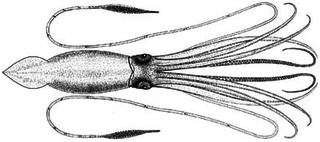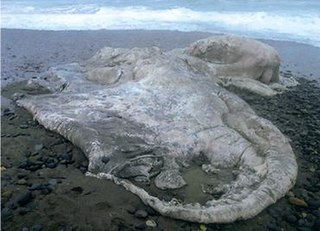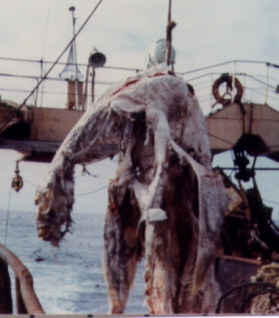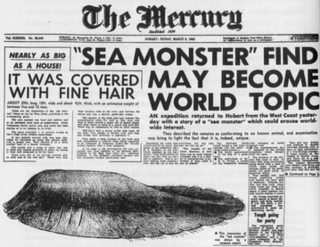
The giant squid is a species of deep-ocean dwelling squid in the family Architeuthidae. It can grow to a tremendous size, offering an example of abyssal gigantism: recent estimates put the maximum size at around 12–13 m (39–43 ft) for females and 10 m (33 ft) for males, from the posterior fins to the tip of the two long tentacles. This makes it longer than the colossal squid at an estimated 9–10 m (30–33 ft), but substantially lighter, as the tentacles make up most of the length. The mantle of the giant squid is about 2 m long, and the length of the squid excluding its tentacles rarely exceeds 5 m (16 ft). Claims of specimens measuring 20 m (66 ft) or more have not been scientifically documented.

Sea monsters are beings from folklore believed to dwell in the sea and are often imagined to be of immense size. Marine monsters can take many forms, including sea dragons, sea serpents, or tentacled beasts. They can be slimy and scaly and are often pictured threatening ships or spouting jets of water. The definition of a "monster" is subjective; further, some sea monsters may have been based on scientifically accepted creatures, such as whales and types of giant and colossal squid.
Cadborosaurus, nicknamed Caddy by journalist Archie Wills, is a sea serpent in the folklore of regions of the Pacific Coast of North America. Its name is derived from Cadboro Bay in Greater Victoria, British Columbia, and the Greek root word "saurus" meaning lizard or reptile.

Sowerby's beaked whale, also known as the North Atlantic or North Sea beaked whale, is a species of toothed whale. It was the first mesoplodont whale to be described. James Sowerby, an English naturalist and artist, first described the species in 1804 from a skull obtained from a male that had stranded in the Moray Firth, Scotland, in 1800. He named it bidens, which derives from the two teeth present in the jaw, now known to be a very common feature among the genus.

There have been several cases of exploding whale carcasses due to a buildup of gas in the decomposition process. This would occur if a whale stranded itself ashore. Actual explosives have also been used to assist in disposing of whale carcasses, ordinarily after towing the carcass out to sea, and as part of a beach cleaning effort. It was reported as early as 1928, when an attempt to preserve a carcass failed due to faulty chemical usages.

The Chilean blob or Chilean monster was a large globster found on Pinuno Beach in Los Muermos, Chile in July 2003. It weighed 13 tonnes and measured 12 metres (39 ft) across. The Chilean blob made headlines around the world because biologists were initially unable to identify it and were speculating that it was the remains of some species of giant octopus previously unknown to science. The blob was the subject of a number of conspiracy theories.

Trunko is the nickname for a large unidentified lump of flesh or a decomposed sea creature, a so-called "globster", reportedly sighted in Margate, South Africa on 25 October 1924. The initial source for Trunko was an article entitled "Fish Like A Polar Bear" published on 27 December 1924, edition of London's Daily Mail. The animal was reportedly first seen off the coast battling two killer whales, which fought the unusual creature for three hours. It used its tail to attack the whales and reportedly lifted itself out of the water by about 20 feet (6 m). One of the witnesses, South African farmer Hugh Ballance, described the animal as looking like a "giant polar bear" due to what was thought to be dense-white fur.

Cetacean stranding, commonly known as beaching, is a phenomenon in which whales and dolphins strand themselves on land, usually on a beach. Beached whales often die due to dehydration, collapsing under their own weight, or drowning when high tide covers the blowhole. Cetacean stranding has occurred since before recorded history.

Muriwai, also called Muriwai Beach, is a coastal community on the west coast of the Auckland Region in the North Island of New Zealand. The black-sand surf beach and surrounding area is a popular recreational area for Aucklanders. The Muriwai Regional Park includes a nesting site for a large colony of gannets.

Cetology or whalelore is the branch of marine mammal science that studies the approximately eighty species of whales, dolphins, and porpoises in the scientific infraorder Cetacea. Cetologists, or those who practice cetology, seek to understand and explain cetacean evolution, distribution, morphology, behavior, community dynamics, and other topics.

A globster or blob is an unidentified organic mass that washes up on the shoreline of an ocean or other body of water. A globster is distinguished from a normal beached carcass by being hard to identify, at least by initial untrained observers, and by creating controversy as to its identity.

The Zuiyo-maru carcass was a corpse, caught by the Japanese fishing trawler Zuiyō Maru (瑞洋丸) off the coast of New Zealand in 1977. The carcass's peculiar appearance resulted in speculation that it might be the remains of a sea serpent or prehistoric plesiosaur.

The spade-toothed whale is the rarest species of beaked whale. As of a find in 2024, only six specimens have been confirmed, all in the South Pacific, five in New Zealand and one in Chile. Very little is known about the species.

The St. Augustine Monster is the name given to a large carcass, originally postulated to be the remains of a gigantic octopus, that washed ashore on the United States coast near St. Augustine, Florida in 1896. It is sometimes referred to as the Florida Monster or the St. Augustine Giant Octopus and is one of the earliest recorded examples of a globster. The species that the carcass supposedly represented has been assigned the binomial names Octopus giganteus and Otoctopus giganteus, although these are not valid under the rules of the ICZN.

The Tasmanian Globster was a large unidentified carcass that washed ashore 2 miles north of Interview River in western Tasmania, in August 1960. It measured 20 ft (6.1 m) by 18 ft (5.5 m) and was estimated to weigh between 5 and 10 tons. The mass lacked eyes and in place of a mouth, had "soft, tusk-like protuberances". It had a spine, six soft, fleshy 'arms' and stiff, white bristles covering its body.

Tecolutla is a town and municipality located on the Tecolutla River on the eastern coast of the state of Veracruz in Mexico. It has the closest beaches to Mexico City, and much of its economy is based on tourism, as it is only a four- or five-hour drive from the capital. It is the northern end of a tourist corridor along the Gulf of Mexico called the "Emerald Coast," which extends down to the city of Veracruz.

The "Montauk Monster" was an animal carcass that washed ashore on a beach near the business district of Montauk, New York, in July 2008. The identity of the creature and the veracity of stories surrounding it have been the subject of controversy and speculation. The corpse was eventually decided by experts to be that of a water-degraded raccoon.
Cryptid whales are cetaceans claimed to exist by cryptozoologists on the basis of informal sightings, but not accepted by taxonomists as they lack formal descriptions of type specimens. Over the past few hundred years, sailors and whalers have reported seeing whales they cannot identify. The most well-known are Giglioli's Whale, the rhinoceros dolphin, Trunko, the high-finned sperm whale, and the Alula whale.

A drift whale is a cetacean mammal that has died at sea and floated into shore. This is in contrast to a beached or stranded whale, which reaches land alive and may die there or regain safety in the ocean. Most cetaceans that die, from natural causes or predators, do not wind up on land; most die far offshore and sink deep to become novel ecological zones known as whale falls. Some species that wash ashore are scientifically dolphins, i.e. members of the family Delphinidae, but for ease of use, this article treats them all as "drift whales". For example, one species notorious for mass strandings is the pilot whale, also known as "blackfish", which is taxonomically a dolphin.
















